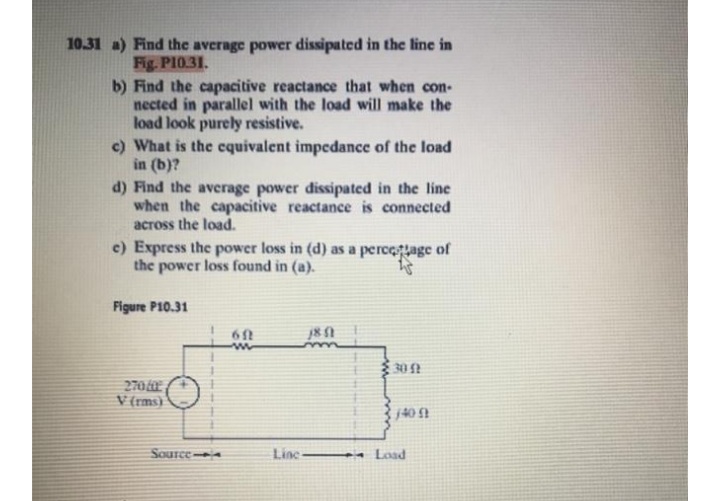31 a) Find the average power dissipated in the line in Fig. P10.31. b) Find the capacitive reactance that when con- nected in parallel with the load will make the load look purely resistive. c) What is the cquivalent impedance of the load in (b)? d) Find the average power dissipated in the line when the capacitive reactance is connected across the load. c) Express the power loss in (d) as a percettage of the power loss found in (a). Figure P10.31 61 30 t 27040 V (rms) Source. Line- - Load
31 a) Find the average power dissipated in the line in Fig. P10.31. b) Find the capacitive reactance that when con- nected in parallel with the load will make the load look purely resistive. c) What is the cquivalent impedance of the load in (b)? d) Find the average power dissipated in the line when the capacitive reactance is connected across the load. c) Express the power loss in (d) as a percettage of the power loss found in (a). Figure P10.31 61 30 t 27040 V (rms) Source. Line- - Load
Power System Analysis and Design (MindTap Course List)
6th Edition
ISBN:9781305632134
Author:J. Duncan Glover, Thomas Overbye, Mulukutla S. Sarma
Publisher:J. Duncan Glover, Thomas Overbye, Mulukutla S. Sarma
Chapter2: Fundamentals
Section: Chapter Questions
Problem 2.3P: The instantaneous voltage across a circuit element is v(t)=400sin(t+30)volts, and the instantaneous...
Related questions
Question
Solve letter b

Transcribed Image Text:10.31 a) Find the average power dissipated in the line in
Fig. PI0.31.
b) Find the capacitive reactance that when con-
nected in parallel with the load will make the
load look purely resistive.
c) What is the equivalent impedance of the load
in (b)?
d) Find the average power dissipated in the line
when the capacitive reactance is connected
across the load.
c) Express the power loss in (d) as a percegage of
the power loss found in (a).
Figure P10.31
61
多02
270
V (rms)
Source
Line-
- Load
Expert Solution
This question has been solved!
Explore an expertly crafted, step-by-step solution for a thorough understanding of key concepts.
This is a popular solution!
Trending now
This is a popular solution!
Step by step
Solved in 3 steps with 3 images

Knowledge Booster
Learn more about
Need a deep-dive on the concept behind this application? Look no further. Learn more about this topic, electrical-engineering and related others by exploring similar questions and additional content below.Recommended textbooks for you

Power System Analysis and Design (MindTap Course …
Electrical Engineering
ISBN:
9781305632134
Author:
J. Duncan Glover, Thomas Overbye, Mulukutla S. Sarma
Publisher:
Cengage Learning

Power System Analysis and Design (MindTap Course …
Electrical Engineering
ISBN:
9781305632134
Author:
J. Duncan Glover, Thomas Overbye, Mulukutla S. Sarma
Publisher:
Cengage Learning